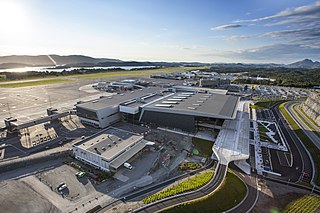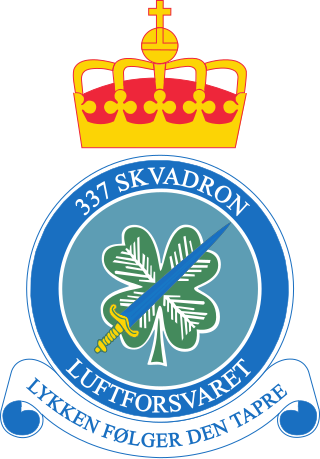
Fedje is an island municipality in the Nordhordland region of Vestland county, Norway. The administrative centre of the municipality is the village of Fedje. The traditional economic activity of the inhabitants is fishing.

Bergen Airport, alternatively Bergen Flesland Airport or simply Flesland Airport, is an international airport located at Flesland in the city and municipality of Bergen, Vestland, Norway. Opened in 1955, it is the second-busiest airport in Norway, with 6,306,623 passenger operations in 2018. Flesland is operated by the state-owned Avinor. Until 1999, Flesland Air Station of the Norwegian Air Force was co-located at the airport.

Coast Air AS was a regional airline based at Haugesund Airport, Karmøy in Norway. It was Norway's fourth largest airline and operated domestic services within Norway, in addition to international services. Routes were concentrated along the West Coast, as well as some public service obligation contracts in Southern Norway. The company had a fleet of de Havilland Canada Twin Otter aircraft, later replaced with Jetstream 31s and ATR 42s.

HNoMS Helge Ingstad was a Fridtjof Nansen-class frigate of the Royal Norwegian Navy. The vessel was ordered on 23 June 2000 and constructed by Navantia in Spain. The ship was launched on 23 November 2007 and commissioned on 29 November 2009. Named for Helge Ingstad, a Norwegian explorer, the Fridtjof Nansen class are capable of anti-air, anti-submarine and surface warfare. On 8 November 2018, HNoMS Helge Ingstad was in a collision with the tanker Sola TS in Norwegian waters just outside Sture Terminal. Helge Ingstad was severely damaged in the collision and ran aground. On 13 November 2018, the ship sank where she had run aground and became a constructive total loss.

NSB Class 73 is a class of 22 electric multiple units built by Adtranz for the Norwegian State Railways. The four-car trains were modifications of Class 71, which was again based on the Swedish X2. The A-series consists of 16 intercity trains; they were delivered in 1999 and 2000 and are used on the Bergen, Dovre and Sørland Lines. The intercity service was branded as Signatur until 2003. The B-series consists of six regional trains delivered in 2002 and used on the Østfold Line. The regional trains were originally part of the Agenda concept. The trains have a power output of 2,646 kilowatts (3,548 hp) and a maximum speed of 210 km/h (130 mph). They have an overall length of 108 meters (354 ft) and have a capacity for 208 seated passengers in the A-series and 250 in the B-series. The trains have a tilting mechanism allowing for faster travel through curves.

Color Air AS was the first Norwegian low-cost airline. It operated from Oslo Airport, Gardermoen in 1998 and 1999 with a fleet of three Boeing 737-300 aircraft. Color Air was a brand extension of Color Line, which shared a common owner in the Olav Nils Sunde-controlled Color Group. The airline operated five daily round trips from Oslo to Trondheim and Bergen, four to Ålesund and one to London, in addition to a weekly trip to Alicante. Color Air pioneered the low-cost business model in Norway, with a denser seating, no frills and lack of a frequent flyer program. Tickets were sold only via the Internet, by telephone or in supermarkets; when bought from travel agents, there was a 200 kr surcharge.

Lufttransport is a Norwegian helicopter and fixed-wing airline that operates primarily air ambulance helicopters and planes for the Norwegian and Swedish governments. In addition the airline offers services including surveillance for the Norwegian Coast Guard, transport of ship pilots and scheduled air transport in the Norwegian territory of Svalbard.
Telenor Kystradio is a part of Telenor and provides maritime telecommunication services along the coast of Norway, operating networks of marine VHF radio, medium frequency, high frequency and Navtex transmitters. As of January 2018 there are two coastal radio stations in Norway, Kystradio nord and Kystradio sør. The agency also issues marine radio licenses for both commercial- and pleasure ships, including callsigns and Maritime Mobile Service Identities, as well as radio operator certificates. Telenor Kystradio head office is based at Telenor Norway's head office at Fornebu. Telenor Kystradio also performs GMDSS Radio inspections, and are approved by the Norwegian Maritime Authority as well as most mayor classification authorities. The Radioinspeksjonen is located in Oslo, Stavanger, Bergen, Ålesund, Sandnessjøen, Bodø, Lofoten and Troms.

Hamar Airport, Stafsberg is a general aviation airport located at Stafsberg in Hamar, Norway. It features a 944-by-23-meter runway aligned 15–33 and is owned by Hamar Municipality. The airport is located in an area with very stable climate and good flying conditions.
Bjarne Winter Thorsen was a Norwegian resistance member during World War II and later a naval officer.
Leif Utne was a Norwegian resistance member during World War II and later a physician.
Braathens Helikopter A/S was a Norwegian helicopter airline based at Stavanger Airport and Bergen Airport. It used a fleet of seven Aérospatiale Super Pumas to serve offshore oil platforms in the North Sea. The customers were Amoco, BP, Norsk Hydro, Phillips Petroleum and Statoil, serving their oil fields Ekofisk, Oseberg, Gullfaks, Veslefrikk, Valhall, Ula and Gyda. Braathens Helikopter operated from 1989 to 1993, after which it was sold to and merged with the main competitor, Helikopter Service. Braathens Helikopter was owned by Ludvig G. Braathens Rederi and was a sister company of the airline Braathens SAFE.

The Havørn Accident was a controlled flight into terrain of a German Junkers Ju 52 aircraft into the mountain Lihesten in Hyllestad, Norway on 16 June 1936 at 07:00. The aircraft, operated by Norwegian Air Lines, was en route from Bergen to Tromsø. The pilots were unaware that they were flying a course parallel to the one planned 15 to 20 kilometers farther east. The crew of four and three passengers were all killed in what was the first fatal aviation accident in Norway. The aircraft landed on a shelf on the mountain face. A first expedition found four bodies, but attempts to reach the shelf with the main part of the aircraft and three more bodies failed. A second party sent two days later, coordinated by Bernt Balchen and led by Boye Schlytter and Henning Tønsberg, succeeded in recovering the remaining bodies.
The Kvikk case is about a variety of birth defects in the children of the men who served on HNoMS Kvikk, a Royal Norwegian Navy fast patrol boat (FPB) of the Snøgg class.

The 337 Squadron is a maritime helicopter unit of the Royal Norwegian Air Force (RNoAF). Based at Bardufoss Air Station, the squadron most recently operated eight NHIndustries NH90 until June 2022. The helicopters were used by the Norwegian Coast Guard and served on the Nordkapp-class, the Barentshav-class and on NoCGV Svalbard.

Fedje Heliport, Høgden is a municipal heliport situated on the island of Fedje in Fedje, Norway. It is predominantly used to fly maritime pilots out of the pilot station at Fedje Vessel Traffic Service Centre. It is also used by air ambulances and as an emergency landing site for offshore helicopters. The heliport was built in 1994.

Kvitsøy Vessel Traffic Service Centre, commonly abbreviated Kvitsøy VTS, is a vessel traffic service and pilot dispatch station situated on the island municipality of Kvitsøy in Norway. Its main responsibility is handling traffic headed to the gas terminal at Kårstø, as well as the entire coast between Bømlafjorden and Jærens rev. This includes Boknafjorden.
The Naval Pilot Authority was a government agency responsible for maritime pilotage in Norway between 1899 and 1974. Its central administration was the Naval Pilot Directorate in Oslo. The operational organization consisted of a varying number of district offices. The authority became part of the Norwegian Coastal Administration from 1 June 1974.
Vardø Vessel Traffic Service Centre, also known as Norwegian Oceanic Region Vessel Traffic Service, is a vessel traffic service situated in the town of Vardø in Vardø Municipality in Finnmark county, Norway. It is responsible for monitoring ship traffic off the baseline of Norway throughout the exclusive economic zone (EEZ), including the areas around Jan Mayen and Svalbard. It has special responsibilities for the sealanes into Hammerfest and Sveagruva.

The Helge Ingstad collision was a ship collision between the Norwegian frigate Helge Ingstad and the Maltese tanker Sola TS. The accident happened on the night of 8 November 2018 in the Hjeltefjorden north of the Sture Terminal in Øygarden.















